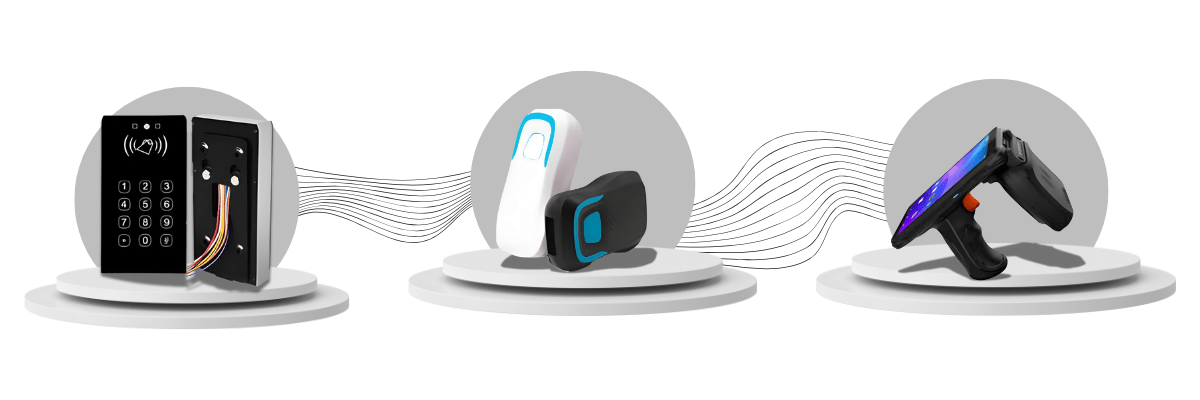How to Choose Low-Frequency RFID Readers
Selecting the right low-frequency (LF) RFID reader is critical for achieving optimal performance in applications where proximity and short-range reads are required. LF RFID operates at 125 kHz to 134.2 kHz, making it suitable for applications such as access control, livestock tracking, and tool identification. These readers are especially effective in environments with high interference from liquids or metals.
1. Application Considerations
The first step in choosing an LF RFID reader is understanding the specific requirements of your application. LF RFID readers are commonly used in:
- Access Control Systems: In secure buildings, LF RFID readers provide reliable short-range reads for keycards, fobs, or other access tokens.
- Animal Tracking: LF readers are the go-to solution for tracking animals because they are not affected by liquids like water, making them ideal for livestock identification.
- Industrial Tool Tracking: In industrial settings where tools and equipment must be monitored, LF readers can accurately track items embedded with LF RFID tags, even in metal-heavy environments.
2. Read Range and Sensitivity
LF RFID readers generally offer a short read range, usually between 2 to 10 cm. The proximity nature of these readers makes them ideal for controlled environments where precise reads are required.
- Short-Range Reads: If your application involves access control or tool tracking, a reader with a short-range is sufficient and ensures secure data capture within close proximity.
- Read Sensitivity: Some LF RFID readers are more sensitive than others, allowing them to perform well in environments with high interference from metals or liquids. This is important in agricultural or industrial settings where environmental factors can reduce read performance.
3. Environmental Durability
When choosing an LF RFID reader, consider the physical environment in which it will be used. Different environments require readers with varying levels of durability and environmental resistance.
- Indoor Use: For office settings and other controlled environments, standard LF RFID readers are adequate. These readers are often integrated into walls or door frames and don’t require additional ruggedization.
- Outdoor or Harsh Environments: For livestock tracking or industrial applications, you will need a reader that is weatherproof, shock-resistant, and able to operate in extreme temperatures. Rugged LF RFID readers can withstand dirt, moisture, and physical wear, ensuring reliable performance in tough conditions.
4. Connectivity and Integration
Depending on your overall system architecture, you may need different connectivity options for your LF RFID reader. Ensure that the reader can easily integrate with your existing infrastructure.
- Wired vs. Wireless Connectivity: Some readers support wireless communication (Wi-Fi or Bluetooth), while others are wired (Ethernet, RS232, USB). Wireless readers are ideal for remote or mobile applications, while wired solutions are preferred for fixed installations in controlled environments.
- System Integration: For seamless data flow, check if the LF RFID reader supports easy integration with existing software, middleware, or databases. Compatibility with standard protocols such as TCP/IP or HTTP may also be required for specific applications.
5. Power Options
LF RFID readers can come with various power options, depending on how and where they will be deployed.
- AC-Powered Readers: Ideal for fixed installations such as access control systems, where readers can be powered through a standard AC outlet.
- Battery-Powered or Portable Readers: For mobile or outdoor use, consider readers with battery power or portable designs, which are suitable for use in remote areas such as farms or industrial sites.
6. Reader Output and Data Handling
Depending on the application, you may need specific output options for data capture. Some LF RFID readers provide basic identification data, while others offer more complex output formats.
- Basic Data Capture: For applications like access control, where only an identification number is needed, a simple reader with limited data output is sufficient.
- Complex Data Needs: If your application requires detailed tracking of livestock, equipment, or tools, select an LF RFID reader that can capture and process more complex data sets. This could include additional identification details, timestamps, and location data.
7. Customization Options
For specialized applications, some readers offer customization options, such as specific housings, mounting options, or additional sensors to enhance their functionality.
- Mounting Solutions: Consider how the reader will be mounted, whether it’s on a gate for livestock tracking or near doors for access control. Some readers offer flexible mounting configurations to fit unique needs.
- Custom Firmware: In more advanced applications, readers with programmable firmware may offer enhanced customization for integrating specific workflows or data processing functions.
Case Studies:
- Access Control in San Francisco, CA: A large corporate office in San Francisco implemented LF RFID readers for employee access control. With short-range readers installed at key entry points, they achieved secure and efficient access management for hundreds of employees.
- Livestock Monitoring in Austin, TX: A cattle farm in Austin upgraded its livestock management system with rugged outdoor LF RFID readers to track animal movements. The solution provided reliable reads even in harsh outdoor conditions, improving overall farm management.
- Tool Tracking in Toronto, ON: An industrial plant in Toronto adopted LF RFID readers to monitor their tools and equipment. The readers were able to accurately capture data despite high metal interference, streamlining tool management and reducing losses.
Our products are in stock and can be shipped overnight to Continental U.S. and Canada from one of our local warehouses. If you have any questions, our technical experts can help you. Please fill out this form or email us.

